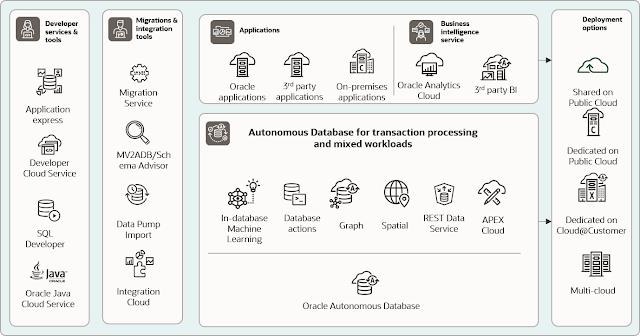Shifting data, databases, and applications from on-premises environments to the cloud is accelerating as cloud technology evolves to support business-critical applications for all types and sizes of organizations. Like you, many of our customers have started to make this shift and are evaluating different options for taking their on-premises Oracle Database workloads to the cloud. There are many factors to evaluate before taking the first step of your cloud journey.
Many organizations that run Oracle Database Standard Edition on-premises for OLTP, analytical, or mixed workloads are considering upgrading to a fully managed Oracle Autonomous Database in Oracle Cloud Infrastructure (OCI) or consolidating many databases using Autonomous Database on Exadata Cloud@Customer in their data centers. Within this context, let’s look at the business and technology benefits.
Why Migrate to Oracle Autonomous Database?
There are several compelling reasons for moving your on-premises Oracle Database Standard Edition to Autonomous Database in the cloud:
◉ Autonomous operations: As a fully managed service, Autonomous Database eliminates the vast majority of labor-intensive manual DBA tasks. It uses machine learning and decades of production-proven best practices to optimize performance and availability. Autonomous Database delivers a fully autonomous experience that includes automatic database tuning, scaling, patching, and securing capabilities. As a result, Autonomous Database doesn’t require extensive database administrator and infrastructure management expertise, so it reduces operational costs and allows resources to be applied to more strategic business priorities. Built-in autonomous capabilities such as Oracle APEX and AutoML accelerate application development cycles and shorten the time-to-first-revenue for new products and services.
◉ Advanced features:
◉ Moving to Autonomous Database delivers industry-first capabilities that are architected to solve pervasive user problems that require expert-level administrators to perform manual database diagnostic, performance tuning, capacity planning, manual backups, and security tasks. Autonomous Database capabilities that are unavailable with Oracle Database Standard Edition specifically eliminate these and many other problems. Instead, machine learning tunes database performance in real-time, makes sure patches are correctly applied without disruption automatically, detects and remediates unauthorized intruders as soon as they try to access your data, and scales performance and capacity up and down based on demand—all without interrupting operations.
◉ That’s not all. The Oracle Autonomous Database includes all of the features/functionality of the Oracle Database Enterprise Edition, many of which are not available in Standard Edition environments. Capabilities such as Transparent Data Encryption (TDE), multiple container databases (CDB), partitioning, compression, parallel query, in-memory columnar format, advanced analytics and more. And you can get Autonomous Database in Oracle Cloud Infrastructure (OCI) or in the comfort and convenience of your own data center on Exadata Cloud@Customer.
◉ Latest infrastructure: Your current on-premises hardware may be several years old. You may also be reaching the end of its maintenance period or lifecycle. Autonomous Database running in OCI data centers is a better option than refreshing your current hardware because: (1) there is no hardware investment, and you pay only for the resources that you use in a subscription service; and (2) Autonomous Database runs on Oracle Exadata infrastructure that is specifically and uniquely architected for optimal Oracle Database performance in the cloud. Customers with extensive Standard Edition deployments combined with data sovereignty concerns can also move to Autonomous Database by running it on Exadata Cloud@Customer installed in their data centers or in co-location facilities such as Equinix.
◉ Higher performance: Oracle Autonomous Database is production-proven to deliver better application performance. Autonomous Database uses advanced Exadata capabilities such as Smart Scan query offloading, Smart Flash Cache, and Automatic Indexing that are not available with Oracle Database Standard Edition to optimize OLTP, analytics, and mixed workload performance. By optimizing SQL queries and offloading data-intensive and compute-intensive workloads to intelligent Exadata storage servers, queries run much faster. This means that workloads require fewer vCPU-seconds to complete, resulting in lower costs.
◉ Consistent data protection and security: Applying the latest software patch is often easier said than done, particularly when you need to patch your entire stack of server, storage, and networking infrastructure in addition to Oracle Database itself. Patching self-managed databases and infrastructure is often delayed by more than three months after patches are available because of the complexity of testing the compatibility of patches from multiple vendors. Delays in patching expose customer databases to security vulnerabilities even when there is a known way to prevent them. Autonomous Database automatically and non-disruptively applies the latest security patches across the database stack as soon as they are available.
◉ High Availability: Autonomous Database provides more than 99.95% availability using fully redundant Exadata infrastructure combined with Oracle Real Application Clusters (RAC), Autonomous Data Guard, automatic backups, and automated failure detection and failover in OCI.
◉ Automatic Scaling: Autonomous Database automatically scales vCPU consumption up and down based on current workload requirements—not on some estimate of what peak resources may be at some distant time in the future. Customers often oversize both cloud and on-premises architectures because they want to avoid the downtime and costs associated with upgrading them. Autonomous Database in OCI and on Exadata Cloud@Customer eliminates downtime by enabling online resource scaling, avoiding the problem of over-provisioning by automatically optimizing both performance and cost. Conventional on-premises systems clearly don’t allow you to scale resource consumption online, but most database cloud services don’t allow you to do it either. With per-second-billing on Autonomous Database, the end result is that you only pay for the resources you use, not what you think you may use in the future.





0 comments:
Post a Comment